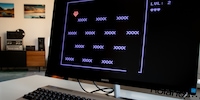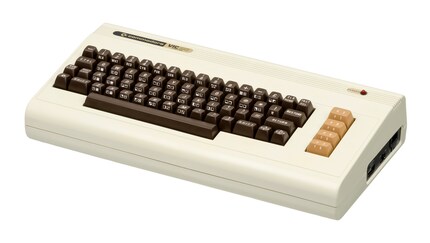
Background information
A soft spot for homemade retro games
by David Lee

By chance I discover a game called "The Keep" on my C64 replica. The more I learn about its background, the more my jaw drops.
On the Commodore knock-off "The C64", which I recently newly bought, there are a number of pre-installed games.The C64-25732", which I recently bought new, has a number of pre-installed games. One of them is called "The Keep". At first glance, the only special thing about the game is the graphics - they are particularly bad. It only covers a tiny area of the screen and is so coarsely pixelated that I don't immediately understand what I'm looking at. Only with time do I realise: I am running through a walled labyrinth, similar to Wolfenstein 3D or Doom. Only without enemies, without weapons and with a much poorer presentation.
There are many doors in the labyrinth. To open them, I have to collect enough keys. Every key fits into every door. My lamp goes out at some point - if I haven't found the exit from the maze by then, the game is over. Otherwise I move on to the next labyrinth. I can display an overview map, the levels are predefined or randomly generated as desired.
So far, so boring. But the developer of this game deserves great respect for making do with absurdly few resources.
The game was released in 2011, and there are some games in this collection that were released in the 21st century, long after the heyday of the C64. However, The Keep is not a game for the C64, but for the VIC-20 - also known as the VIC-20 in German-speaking countries. This is the predecessor of the C64, and it can also be emulated with my replica "The C64". VIC-20 games do not run on the original C64.

The VIC-20 looks very similar to the C64, but doesn't come close to it in terms of performance. It dates from 1980 and has only 5 kilobytes (KB) of RAM. That's not even a twelfth of the C64 and about a million times less than your smartphone has. Even for 1980, that was little. The VIC-20 stood out mainly because it was cheap to buy. Commodore boss Jack Tramiel's strategy worked: Commodore sold 2.5 million units of the VIC-20 - at a time when nobody even knew what a computer at home was for.
Of the measly 5 KB of RAM, 1.5 KB is used by the system. What remains is a laughable 3.5 KB. The entire programme code and the video RAM must be accommodated in this, as there is no graphics unit with its own RAM.
If the VIC-20 had to display an image with 64 × 64 pixels in today's standard colour depth of 8 bits, it would need 4 KB. The RAM is therefore not even sufficient to display a small icon. And not a single bit of programme code has been read in yet.
In other words, the VIC-20 has not much more computing power than your toilet paper holder.
In any case, it is not possible to control individual pixels on the VIC-20. The machine does not know any graphics mode; it can only display letters, numbers and other characters. This is understandable in view of the tiny working memory. But how can you programme graphic games like that?
Quite simply: by making a graphic out of characters. The VIC-20's built-in character set already comes with a variety of areas, patterns or lines in different thicknesses and directions. This allows you to create so-called block graphics. Here you can see the game Lemmings, which was implemented for the C64 with a graphic made of standard characters:
Much more often than with the standard character set, games work with their own customised character sets. In this way, pixel-precise graphics can still be placed on the VIC-20 through the back door. Figures or larger graphics are composed of one or more characters.
Much of this is done using the standard character set.
This makes many things more difficult than with a proper graphics mode. To make the movement look fluid, it would be necessary to move a figure pixel by pixel instead of character by character. To do this, however, you would have to store all the intermediate steps between two character positions as separate characters for each figure. The amount of characters needed for this would interfere with the VIC-20's micro RAM.
In view of these circumstances, programming a 3D game is bordering on madness.
But there is a method to the madness.
The 3D classic Doom runs just about everywhere: on printers, pregnancy tests and even within Doom itself. You know what's coming next: Doom for the VIC-20. Steve McCrea aka Kweepa has brought Doom to the VIC-20 alongside The Keep. The two games are related.
Printers, ATMs or old mobile phones have more power than the VIC-20. And in the case of the pregnancy test, both the screen and the processor have been replaced. So the VIC-20 port still stands out as particularly ambitious even in these completely insane Doom ports.
The first-person shooter then also runs on the VIC-20 only with memory expansions. With 3.5 KB RAM, that would have been impossible. You can download a disk image of the game. This will run in the Vice emulator, which runs on Mac and Windows. To do this, select "xvic" as the machine and activate all memory extensions in the options. Then you can simply drag the file into the emulator. The Keep also runs this way, but without memory extensions.
I don't really enjoy either "Doom" or "The Keep". But I think it's great that an ancient computer is being revived in this way. In 1980, no one would have thought of programming a 3D shooter. With today's understanding and modern tools, games are possible on old platforms that would never have existed back then. So even for the Commodore 64, some nerds are programming new games and demos every now and then, even though there's no money in it. Or they port classics, for example Super Mario Bros. for the C64. This is usually done without the permission of the copyright holder, which puts them on thin legal ice. In any case, for the VIC-20 and the C64, the selection of games is still getting bigger and better today.
My interest in IT and writing landed me in tech journalism early on (2000). I want to know how we can use technology without being used. Outside of the office, I’m a keen musician who makes up for lacking talent with excessive enthusiasm.
Interesting facts about products, behind-the-scenes looks at manufacturers and deep-dives on interesting people.
Show all